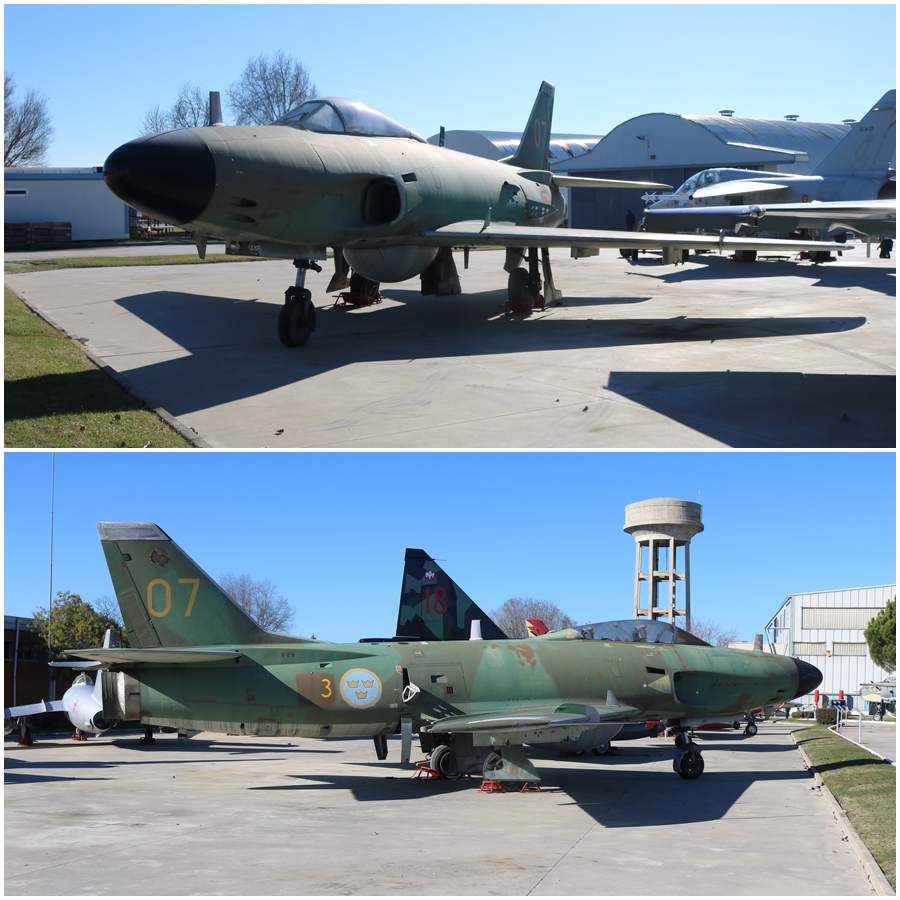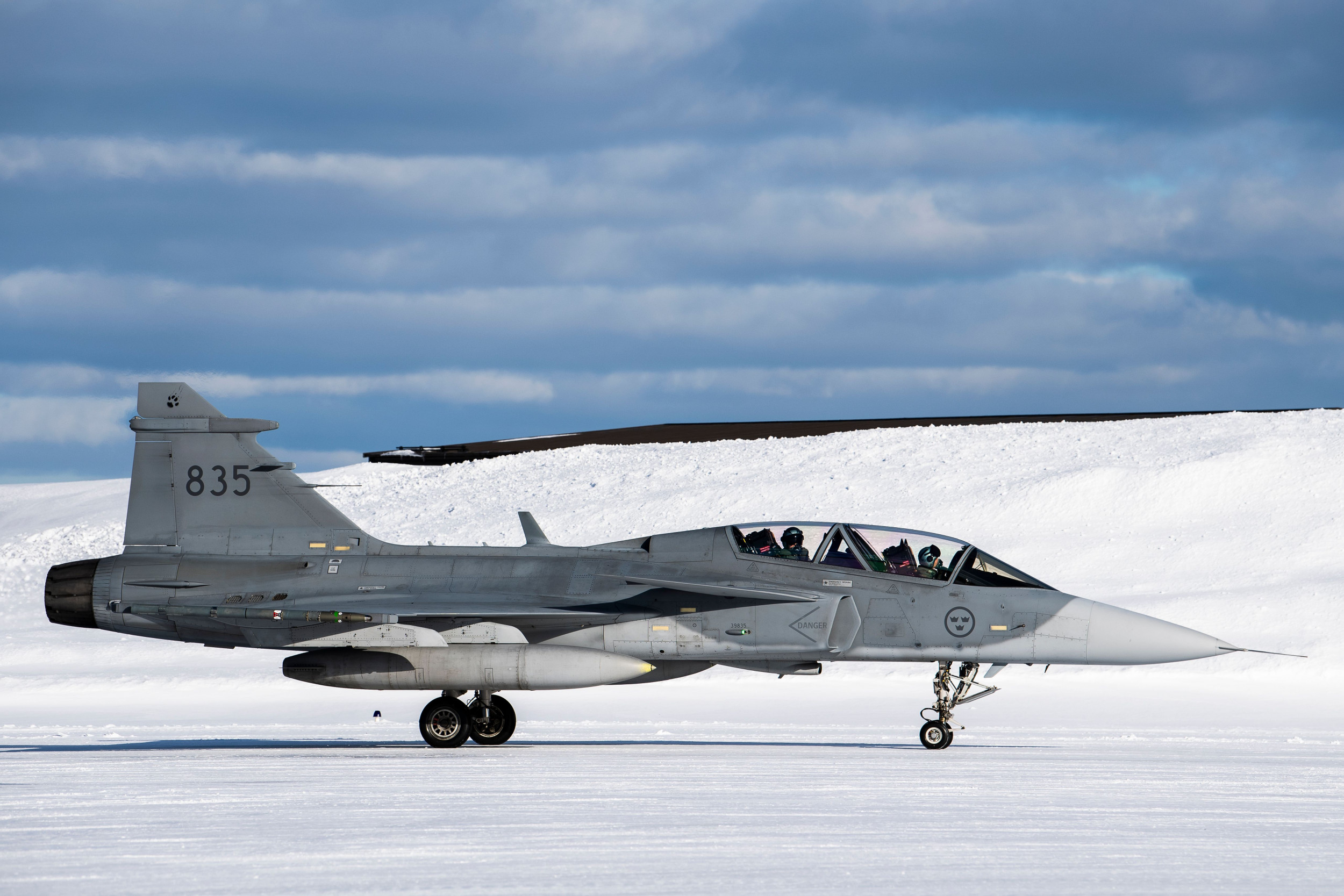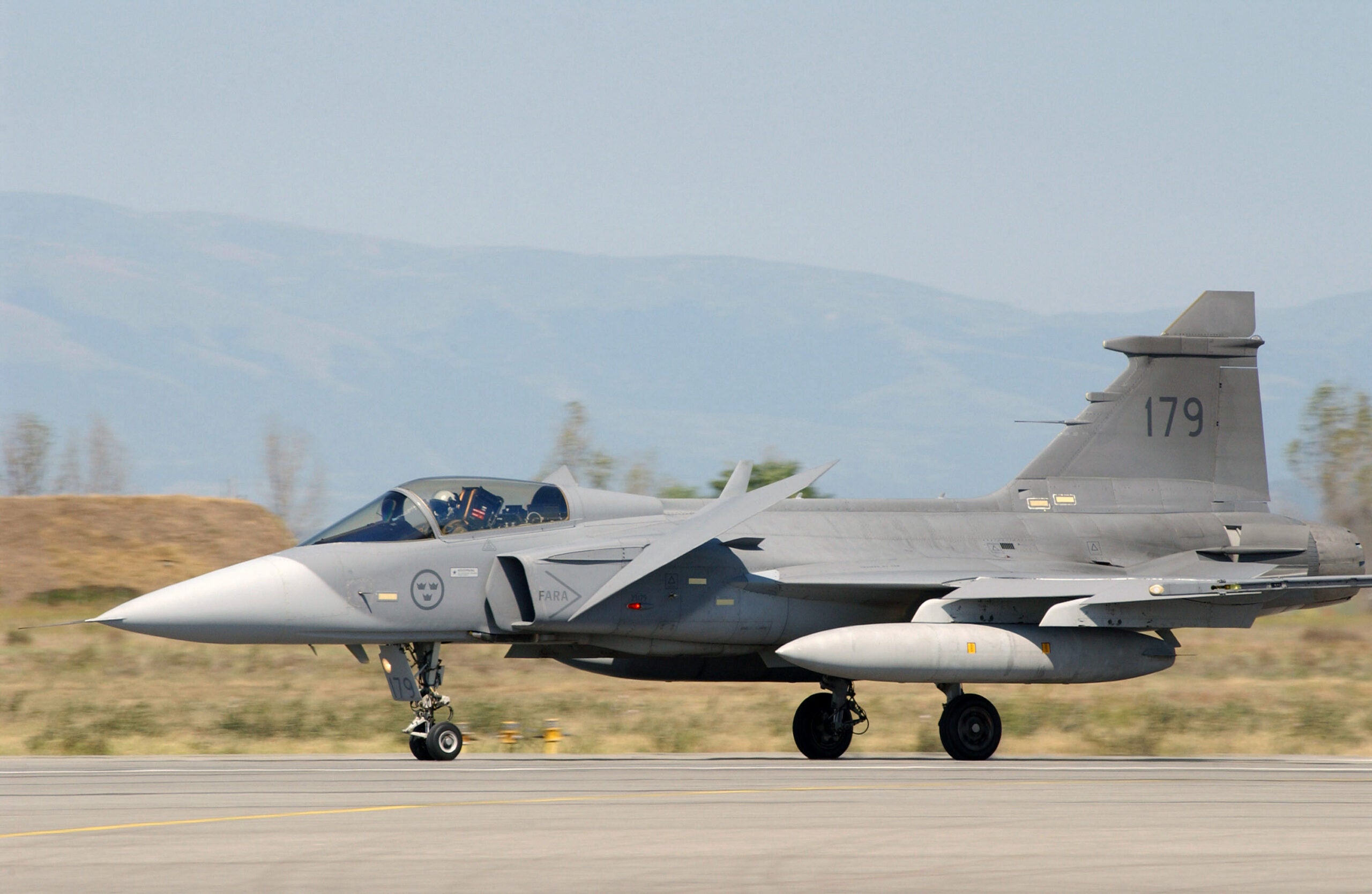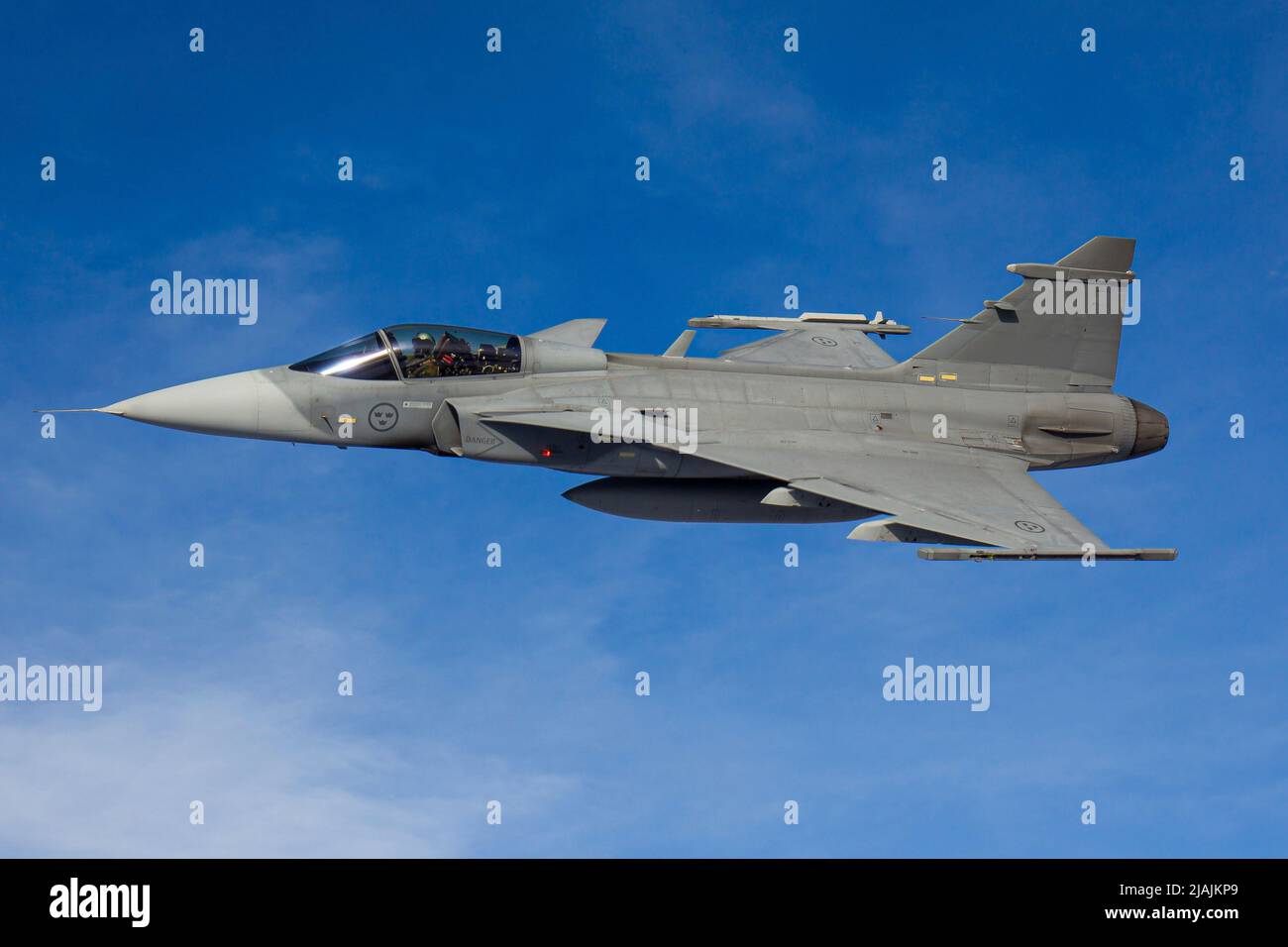Swedish Jet Fighters - A retired Swedish single-seat, single-engine, short- and medium-range combat aircraft. Model development work began at Saab in 1952 and, after opting for a radical delta wing configuration, the resulting aircraft made its first flight on 8 February 1967 and entered service on 21 June 1971. It was first mass-produced canard design.
Fighter jet in Europe, although slower than the earlier MiG-21bis, until the Panavia Tornado entered service in 1981.
Swedish Jet Fighters

Several special Vigg variants were developed to fulfill the roles of strike troops (AJ 37), aerial reconnaissance (SF 37), maritime surveillance aircraft (SH 37) and two-seat trainer (Sk 37). In the late 1970s, the JA 37 all-weather fighter variant was introduced. In November 2005, the Vigg was withdrawn from service by the Swedish Air Force, the sole operator, and replaced by the newer Saab JAS 39 Grip.
Sweden Expects Fighter Fleet Growth, Pilot Training Revamp
The first meaning refers to åskvigg, which in the modern way translates to "thunder". However, there is a tradition for the word "thrumusteinar", prehistoric stone axes found on the ground during the Viking Age ("åsk-vigg" = "thunder wedge"). The Scandinavians of this time thought that these axes were brought down to earth by the thunderbolts of the god Thor when he hunted the giants with his war hammer Mjölnir.
These axes are believed to have magical powers such as lightning protection (because "lightning never strikes the same place twice"). However, over time the word was changed to the Swedish equivalent of the Greek "thunderbolt", and so the name usually refers to it. However, since the name Vigg lacks the "thunder" prefix åsk and is in the Swedish final form, it should be translated as "bolt" referring to this meaning.
The second meaning refers to vigg, the Swedish word for duck. This is a reference to its canard configuration where "canard" is Frch for duck.
The Vigg was originally developed as an intended replacement for the Saab 32 Lans in the attack role and later the Saab 35 Drak as a fighter.
Swedish Jet Fighter, Saab J29 \
In 1955, when Saab's Drak prototype, the world's most advanced fighter at that point, made its first flight, the Swedish Air Force had already established a series of requirements for the next generation of fighters; Due to the demanding nature of these requirements, a long development period is expected and the first flight is not expected to take place until the middle of the next decade.
Between 1952 and 1957, the first studies were carried out on what would become the Vigg, with the participation of the Finnish aircraft designer Aarne Lakomaa. Over 100 different concepts were examined in these studies, which included single and twin wing configurations, conventional and double delta wings, and canard wings. An EV VTOL design was considered, with different elevator pitches, but was soon found to be untenable.
From the beginning, the Vigg was planned as an integrated weapon system, to be used in conjunction with the latest revision of Sweden's national electronic air defense system, the STRIL-60. It is used as the country's standard platform, which can be effectively adapted to perform all tactical missions.

Other requirements include low-level supersonic capability, Mach2 performance at altitude, and the ability to make short landings at low angles of attack (to avoid damaging orbits). The aircraft was also designed from the ground up to be easily repaired and serviced, for example by personnel without extensive training.
Uk In Talks With Sweden Over Next Generation Fighter Jet
A radical requirement of the proposed aircraft was that it could be operated from short runways only 500 meters long; it was part of the Bas 60 air base system adopted by the Swedish Air Force in the late 1950s. Bas 60 is about the deployment of military aircraft in many airfields during the war, including roads that act as alternative runways.
The use of partially damaged airstrips is another factor that encourages STOL capabilities. The Bas 60 was developed into the Bas 90 in the 1970s and 1980s and featured short runways of only 800 meters in length.
In order to perform such operations, a number of important design requirements are set, including a moderate landing speed, a landing without a skid, rapid deceleration after landing, precise control in crosswinds on a slippery surface, and high acceleration during takeoff.
In 1960, the US National Security Council, chaired by President Eishower, formulated a security guarantee for Sweden and pledged US military aid in the event of a possible Soviet attack on Sweden; the two countries signed an agreement on military technology. In the so-called "Annex 37", the Swedes were given access to advanced American aviation technology that made it possible to design and manufacture the Vigg faster and cheaper than otherwise possible.
An Often Overlooked Swedish Fighter May Be The Jet Ukraine Needs To Take On Russia Now, Experts Say
According to a study by Nils Bruzelius of the Swedish National Defense Academy, the reason for this officially unknown US support is to protect the US Polaris submarines located off the east coast of Sweden against the threat from Soviet anti-submarine aircraft.
The connection also seems doubtful because of the time scale - Vigg's strike version only entered service in 1971 and the combat version in 1978, by which time the Polaris had been retired.
In December 1961, the Swedish government gave its approval for the development of the Aircraft System 37, which would eventually become the Vigg.

By 1962, all aspects of the project were in place or nearing completion; this includes the plane itself, the powerplant, ejection seats, weapons, reconnaissance systems, ground handling equipment and training equipment such as simulators.
Saab Secures Fmv Order For Future Fighter Aircraft Development
In February 1962, approval of the general layout was given, followed by a development agreement in October 1962.
According to aviation authors Bill Gunston and Peter Gilchrist, the project is "the largest industrial development project ever attempted in Sweden".
In 1963, Saab completed the aerodynamic design of the aircraft; the aerodynamic configuration is radical: it combines a rear-mounted double delta wing with a small, high-mounted canard front engine, equipped with powered trailing flaps mounted in front and slightly above the main wing; it will be judged as the best way to satisfy the conflicting requirements of STOL performance, supersonic speed, low turbulence at low altitude and effective lift for subsonic flight.
Canards have become common in fighter aircraft, especially the Eurofighter Typhoon, Dassault Rafale, Saab JAS 39 Grip and IAI Kfir, but primarily for the purpose of providing flight agility rather than their STOL capability.
Swedish Air Force
Additional aerodynamic refinements in the later stages of development included the addition of a dog-tooth pattern to the main wing to create vortices, which allowed the blown flaps to be removed from the rudder. The use of thrust rotors enabled the desired short landing performance.
During development, Saab chose to use the model with a large turbo. Initially, the British Rolls-Royce Medway gin was chosen to power the Viggan, which was considered the ideal basis for a supersonic gin with a fully controlled afterburner; However, development of the Medway was abandoned because the intended launch aircraft, the de Havilland Tridt, was downgraded during development.
Instead of the Medway, Saab chose to adopt the production version of the American Pratt & Whitney JT8D engine, the Volvo RM8, instead. The RM8 has been extensively redesigned, with new materials to accommodate flight at Mach-2 speeds, a Swedish afterburner and a fully variable nozzle.

In 1964, the construction of the first prototype aircraft began; on February 8, 1967, the first of a possible seven prototypes made its service flight, which took place according to the established development plan.
Swedish Air Force All Weather Interceptor Fighter Ja37 Saab Vigen 17th Wing
The first flight, which lasted 43 minutes, was flown by Erik Dahlström, Saab's chief test pilot, who said the prototype was easy to handle throughout. Writing at the time, the aerospace publication Flight International described the flight as "Sweden's surprisingly one-sided position in front of advanced aircraft builders..."
Each of the seven prototypes was assigned a different role, although the first aircraft was focused on supporting the development of the initial production variant, the AJ37.
In 1967, the Swedish government concluded that the AJ 37 Vigg under development would be cheaper and better than the McDonnell Douglas F-4 Phantom II.
In April 1968, the Swedish government officially gave permission for Vigg production to continue, placing an order for 175 Viggs that year.
Sweden's Basic Trainer Aircraft Tender Falls Through
In May 1969, Vigg made his first public appearance outside of Sweden at the Paris Air Show.
When the original AJ 37 Vigg entered service, additional Vigg variants continued to complete development and production.
In 1972, the first SK 37, a training trainer variant with a magical second canopy for instructors, was delivered to the Swedish Air Force.

On May 21, 1973, the first prototype of the SF 37 Vigg, a tactical reconnaissance variant with a modified nose to accommodate sev ssors, made its first flight.
Vehicle, Airplane, Aircraft, Military Aircraft, Swedish, Jet Fighter, Sukhoi Su 27, Swedish Air Force, Mikoyan Mig 29, Jas 39 Gripen, Mcdonnell Douglas F 15 Eagle, Air Force, Aviation, Atmosphere Of Earth,
While other variants dropped out of production in the 1960s, Saab continued to produce a more capable all-weather version of the aircraft, the JA 37. By 1970, Sweden's air defenses were being heavily scrutinized and the future JA 37 Vigg was found to be well suited to the role.
On
Jet fighters flying gliders, swedish jet, wwii jet fighters, jet fighters inside out, jet fighters for sale, model jet fighters, russian jet fighters, current us jet fighters, jet fighters videos, us navy jet fighters, fighters jet, diecast jet fighters
0 Comments